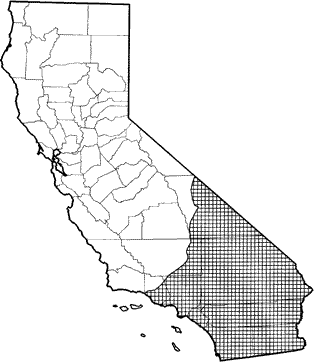
Desert Shrew
Distribution, Abundance, and Seasonality
The desert shrew is a rare to uncommon resident of southern California. Durham (1955) stated it has been found in Santa Barbara, Ventura, Los Angeles, San Bernardino, Riverside, Imperial, San Diego, and Inyo cos. Elevational range is from near sea level in California to about 2150 m (7000 ft) in Colorado. Prefers desert wash, desert scrub, desert riparian, mixed chaparral, and pinyon-juniper habitats (Coulombe and Banta 1964, Ingles 1965, Armstrong and Jones 1972).

Range Map
Specific Habitat Requirements
Feeding: Hoffmeister and Goodpaster (1962) reviewed foods acceptable in the lab, which included mealworms, cutworms, crickets, cockroaches, houseflies, grasshoppers, moths, beetles, earwigs, centipedes, and carcasses of small birds and mammals. Forages on the ground, but little food data found from the wild.
Cover: Kinds of cover utilized by the desert shrew vary with availability, but include piles of brush, logs, rubbish, woodrat nests, and abandoned beehives (Vaughan 1954, Turkowski and Brown 1969, Armstrong and Jones 1972). There is a preference for dense vegetation within suitable habitats, but it has been captured in desert gravel areas in California (Fisher 1941).
Reproduction: Not fossorial in general (Hoffmeister and Goodpaster 1962). Nests of grasses, leaves, spider webs, and inner bark of trees are built by both sexes.
Water: Permanent water not a requisite of suitable habitats, but protected microhabitats are sought. Drinks water when available, otherwise obtains water from food (Ingles 1965, Armstrong and Jones 1972).
Pattern: Generally prefers dense canopy with suitable nest sites.
Species Life History
Activity Patterns: Active yearlong. Dixon (1924) suggested they mostly are nocturnal, but active day and night in captivity (Hoffmeister and Goodpaster 1962).
Seasonal Movements / Migration: No known movements.
Home Range: No data found.
Territory: May not be territorial. Little antagonism between individuals caged together if food is available (Hoffmeister and Goodpaster 1962).
Reproduction: Breeding season seems to extend throughout the warmer months of the year (April to September), but precise information for California is limited. Typical litter is 3-5, no information on number of litters per yr. Young altricial; weaned and leave the nest by 40 days (Hoffmeister and Goodpaster 1962).
Niche: Often associated with woodrat nests and with species of Reithrodontomys, Peromyscus, and Perognathus, but no functional relationships have been established (Durham 1955). Great horned owls and barn owls are known to prey upon desert shrews (Cunningham 1960).
Sources & References
California Department of Fish and Game, 1999.
California's Wildlife, Sacramento, CA.
Written by: G. Hoefler, R. Duke, reviewed by: H. Shellhammer, edited by: R. Duke
Armstrong, D. M., and J. K. Jones, Jr. 1972. Notiosorex crawfordi. Mammal. Species No. 17. 5pp. Coulombe, H. N., and B. H. Banta. 1964. The distribution and ecology of the Crawford desert shrew, Notiosorex crawfordi, in Saline Valley, Inyo County, California. Wasmann J. Biol. 22:277-297. Cunningham, J. D. 1956. Ecology and occurrence of Notiosorex in southern California. J. Mammal. 37:108-110. Cunningham, J. D. 1960. Food habits of the horned and barn owls. Condor 62:222. Dixon, J. 1924. Notes on the life history of the gray shrew. J. Mammal. 5:1-6. Durham, F. E. 1955. The gray shrew, Notiosorex crawfordi, in Los Angeles County, California. J. Mammal. 36:561-562. Fisher, H. I. 1941. Notes on shrews of the genus Notiosorex. J. Mammal. 22:263-264. Hoffmeister, D. F., and W. W. Goodpaster. 1962. Life history of the desert shrew, Notiosorex crawfordi. Southwest. Nat. 7:236-252. Ingles, L. G. 1965. Mammals of the Pacific states. Stanford Univ. Press, Stanford, CA. 506pp. Nowak, R. M., and J. L. Paradiso. 1983. Walker's mammals of the world. 4th ed. 2 vols. John Hopkins Univ. Press, Baltimore, MD. 1362pp. Turkowski, F. J., and C. K. Brown. 1969. Notes on distribution of the desert shrew. Southwest. Nat. 14:128. Vaughan, T. A. 1954. Mammals of the San Gabriel Mountains of California. Univ. Kans., Mus. Nat. Hist. Publ. 7:513-582.
California Animal Facts | California's Wildlife